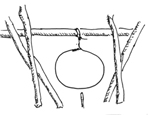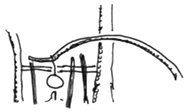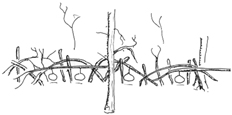Alaska Science Camps, Fairs & Experiments
ANKN is a resource for compiling and exchanging information
related to Alaska Native knowledge systems and ways of knowing. We
are pleased to create and distribute a variety of publications
that assist Native people, government agencies,
educators and the general public in gaining access to the knowledge
base that Alaska Natives have acquired through cumulative experience
over millennia.
TO ORDER THIS PUBLICATION:
Contact the ANKN
offices at 907-474-1902 or email uaf-cxcs@alaska.edu.  Rabbit
Snares Rabbit
Snares
Snaring rabbits has been the first step
into hunting and trapping for many young Alaskans. It has also been
the means for survival for many adults during hard times.
 Population
Cycles Population
Cycles
Rabbits eat willow and alder bark as well as other green shoots.
They eat grass in the summer. Rabbits are, in turn, eaten by many
predators, including fox, lynx, wolverine, wolves, bears, owls, and
eagles. Floods often drown many rabbits, both in the spring and in
the fall. Their population has many other pressures including
sickness.
Setting snares
The first consideration is where to set rabbit snares. They will
be found on islands or on top of banks where the brush is thick. The
best place to set a snare is where there are the most tracks.
There are several variables in setting a successful rabbit snare.
Experiment with the size of the hole. Experiment with the height of
the snare. Experiment with snares that have a fence and those that do
not. Of the snares that have a fence, experiment with live and dead
sticks.

|
|
SAME SIZE, DIFFERENT
HEIGHT
|

|
|
SAME HEIGHT, DIFFERENT
SIZE
|
Also test different kinds of wire. Which is the most durable? Most
people use braided picture hanging wire, but there are different
thicknesses, 5 lb, 40 lb., 60 lb., etc.
 There
are basically two kinds of snares, those that hang the rabbit in the
air and those that do not. The simple kind that does not hang the
rabbit is easy to set, but the rabbits taste a bit strong because
they struggle. The kind of snare that hangs the rabbit in the air
dispatches the rabbit quickly, giving a better taste. There
are basically two kinds of snares, those that hang the rabbit in the
air and those that do not. The simple kind that does not hang the
rabbit is easy to set, but the rabbits taste a bit strong because
they struggle. The kind of snare that hangs the rabbit in the air
dispatches the rabbit quickly, giving a better taste.
Other factors and methods
Snares are usually set for rabbits between freezeup and breakup.
Rabbits can carry disease more in the summer, and people do not
usually eat them unless there is nothing else. When the snow depth is
great, rabbits tend to follow the same trail. When there is little or
no snow , they wander all over and are much harder to catch.
BENT WILLOW
UNDER PRESSURE

We used to have rabbit drives on islands in the winter. A large
group of people would start on one end of an island walking parallel
down the island while making a lot of noise. A few people with .22s
would wait for the rabbits on the other end of the island. This is a
lot of fun, but the people with the .22s must be extremely
careful, or one of the drivers could be shot.

It is much safer to have a rabbit drive with a fence of dead
sticks across the end of the island, and snares in the openings of
the fence. The fence can be used in future rabbit drives too.
|